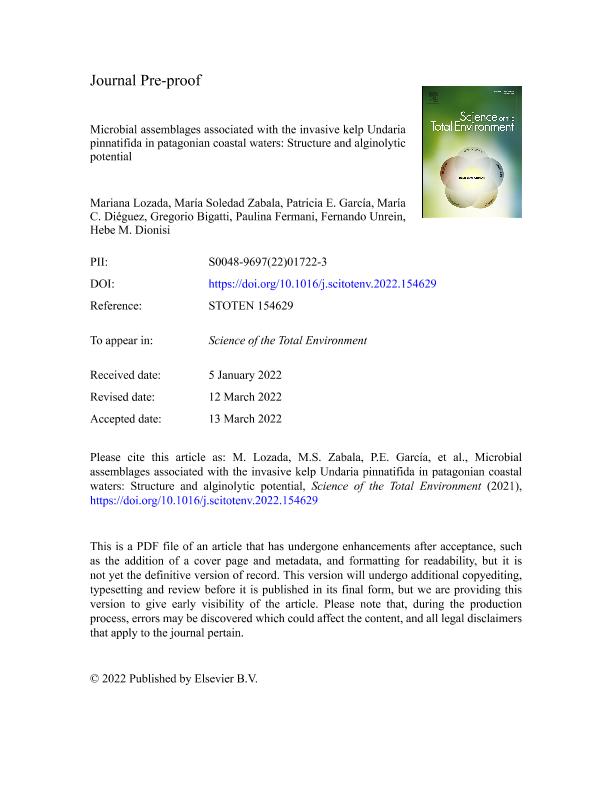Mostrar el registro sencillo del ítem
dc.contributor.author
Lozada, Mariana

dc.contributor.author
Zabala, Maria Soledad

dc.contributor.author
Garcia, Patricia Elizabeth

dc.contributor.author
Dieguez, Maria del Carmen

dc.contributor.author
Bigatti, Gregorio

dc.contributor.author
Fermani, Paulina

dc.contributor.author
Unrein, Fernando

dc.contributor.author
Dionisi, Hebe Monica

dc.date.available
2023-07-06T18:39:25Z
dc.date.issued
2022-07
dc.identifier.citation
Lozada, Mariana; Zabala, Maria Soledad; Garcia, Patricia Elizabeth; Dieguez, Maria del Carmen; Bigatti, Gregorio; et al.; Microbial assemblages associated with the invasive kelp Undaria pinnatifida in Patagonian coastal waters: Structure and alginolytic potential; Elsevier; Science of the Total Environment; 830; 154629; 7-2022; 1-10
dc.identifier.issn
0048-9697
dc.identifier.uri
http://hdl.handle.net/11336/202644
dc.description.abstract
Undaria pinnatifida is a brown algae native to Asia that has settled in various regions worldwide, periodically contributing with large quantities of C and nutrients during its annual cycle. In this work, we analyzed a coastal site in Patagonia (Argentina) that has been colonized for three decades by U. pinnatifida, focusing on associated microbial communities in three different compartments. An important influence of algae was observed in seawater, especially in the bottom of the algal forest during the austral summer (January) at the moment of greater biomass release. This was evidenced by changes in DOC concentration and its quality indicators (higher Freshness and lower Humification index) and higher DIC. Although maximum values of NH4 and PO4 were observed in January, bottom water samples had lower concentrations than surface water, suggesting nutrient consumption by bacteria during algal DOM release. Concomitantly, bacterial abundance peaked, reaching 4.68 ± 1.33 × 105 cells mL −1 (January), showing also higher capability of degrading alginate, a major component of brown algae cell walls. Microbial community structure was influenced by sampling date, season, sampling zone (surface or bottom), and environmental factors (temperature, salinity, pH, dissolved oxygen, nutrients). Samples of epiphytic biofilms showed a distinct community structure compared to seawater, lower diversity, and remarkably high alginolytic capability, suggesting adaptation to degrade algal biomass. A high microdiversity of populations of the genus Leucothrix (Gammaproteobacteria, Thiotrichales) that accounted for a large fraction of epiphytic communities was observed, and changed over time. Epiphytic assemblages shared more taxa with bottom than with surface seawater assemblages, indicating a certain level of exchange between communities in the forest surroundings. This work provides insight into the impact of U. pinnatifida decay on seawater quality, and the role of microbial communities on adapting to massive biomass inputs through rapid DOM turnover.
dc.format
application/pdf
dc.language.iso
eng
dc.publisher
Elsevier

dc.rights
info:eu-repo/semantics/openAccess
dc.rights.uri
https://creativecommons.org/licenses/by-nc-sa/2.5/ar/
dc.subject
COASTAL ENVIRONMENTS
dc.subject
DOM TURNOVER
dc.subject
INVASIVE SEAWEEDS
dc.subject
MICROBIAL COMMUNITIES
dc.subject.classification
Ecología

dc.subject.classification
Ciencias Biológicas

dc.subject.classification
CIENCIAS NATURALES Y EXACTAS

dc.title
Microbial assemblages associated with the invasive kelp Undaria pinnatifida in Patagonian coastal waters: Structure and alginolytic potential
dc.type
info:eu-repo/semantics/article
dc.type
info:ar-repo/semantics/artículo
dc.type
info:eu-repo/semantics/publishedVersion
dc.date.updated
2023-06-29T10:15:47Z
dc.identifier.eissn
1879-1026
dc.journal.volume
830
dc.journal.number
154629
dc.journal.pagination
1-10
dc.journal.pais
Países Bajos

dc.journal.ciudad
Amsterdam
dc.description.fil
Fil: Lozada, Mariana. Consejo Nacional de Investigaciones Científicas y Técnicas. Centro Científico Tecnológico Conicet - Centro Nacional Patagónico. Centro para el Estudio de Sistemas Marinos; Argentina
dc.description.fil
Fil: Zabala, Maria Soledad. Consejo Nacional de Investigaciones Científicas y Técnicas. Centro Científico Tecnológico Conicet - Centro Nacional Patagónico. Instituto de Biología de Organismos Marinos; Argentina
dc.description.fil
Fil: Garcia, Patricia Elizabeth. Consejo Nacional de Investigaciones Científicas y Técnicas. Centro Científico Tecnológico Conicet - Patagonia Norte. Instituto de Investigaciones en Biodiversidad y Medioambiente. Universidad Nacional del Comahue. Centro Regional Universidad Bariloche. Instituto de Investigaciones en Biodiversidad y Medioambiente; Argentina
dc.description.fil
Fil: Dieguez, Maria del Carmen. Consejo Nacional de Investigaciones Científicas y Técnicas. Centro Científico Tecnológico Conicet - Patagonia Norte. Instituto de Investigaciones en Biodiversidad y Medioambiente. Universidad Nacional del Comahue. Centro Regional Universidad Bariloche. Instituto de Investigaciones en Biodiversidad y Medioambiente; Argentina
dc.description.fil
Fil: Bigatti, Gregorio. Consejo Nacional de Investigaciones Científicas y Técnicas. Centro Científico Tecnológico Conicet - Centro Nacional Patagónico. Instituto de Biología de Organismos Marinos; Argentina
dc.description.fil
Fil: Fermani, Paulina. Consejo Nacional de Investigaciones Científicas y Técnicas. Centro Científico Tecnológico Conicet - Centro Nacional Patagónico. Centro para el Estudio de Sistemas Marinos; Argentina
dc.description.fil
Fil: Unrein, Fernando. Universidad Nacional de San Martin. Instituto Tecnologico de Chascomus. - Consejo Nacional de Investigaciones Cientificas y Tecnicas. Centro Cientifico Tecnologico Conicet - la Plata. Instituto Tecnologico de Chascomus.; Argentina
dc.description.fil
Fil: Dionisi, Hebe Monica. Consejo Nacional de Investigaciones Científicas y Técnicas. Centro Científico Tecnológico Conicet - Centro Nacional Patagónico. Centro para el Estudio de Sistemas Marinos; Argentina
dc.journal.title
Science of the Total Environment

dc.relation.alternativeid
info:eu-repo/semantics/altIdentifier/url/https://linkinghub.elsevier.com/retrieve/pii/S0048969722017223
dc.relation.alternativeid
info:eu-repo/semantics/altIdentifier/doi/http://dx.doi.org/10.1016/j.scitotenv.2022.154629
Archivos asociados
